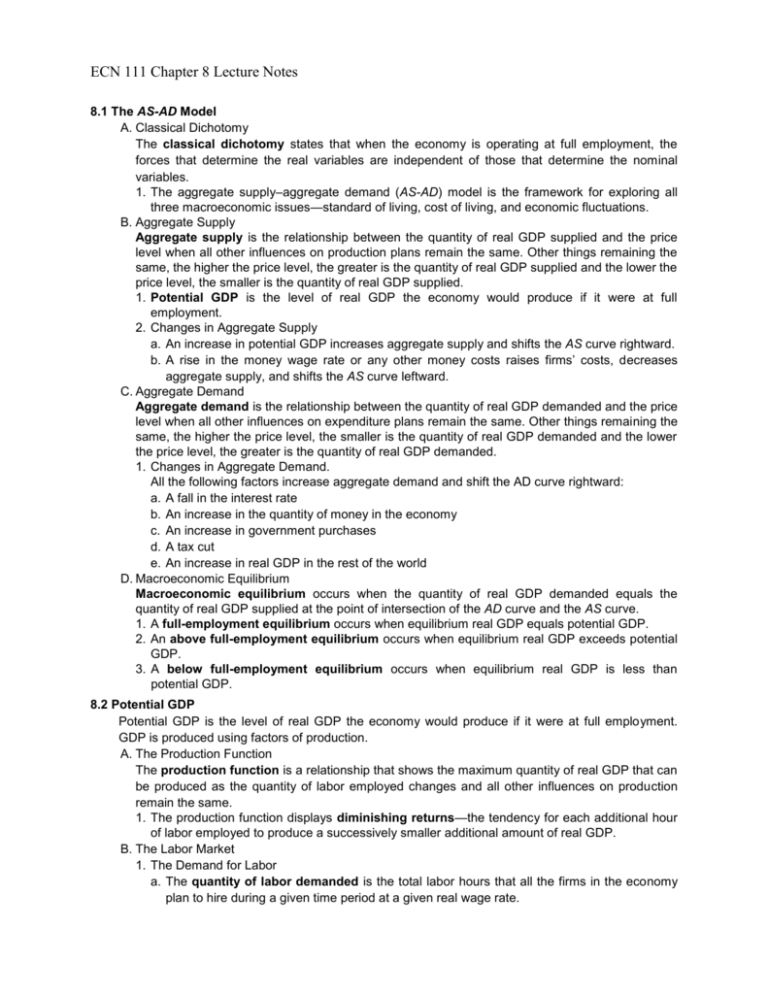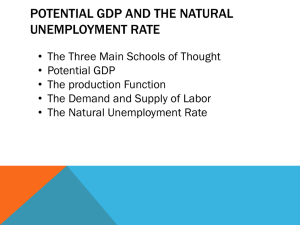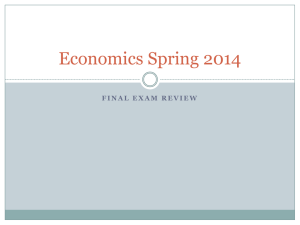ECN 111 Chapter 8 Lecture Notes
advertisement

ECN 111 Chapter 8 Lecture Notes 8.1 The AS-AD Model A. Classical Dichotomy The classical dichotomy states that when the economy is operating at full employment, the forces that determine the real variables are independent of those that determine the nominal variables. 1. The aggregate supply–aggregate demand (AS-AD) model is the framework for exploring all three macroeconomic issues—standard of living, cost of living, and economic fluctuations. B. Aggregate Supply Aggregate supply is the relationship between the quantity of real GDP supplied and the price level when all other influences on production plans remain the same. Other things remaining the same, the higher the price level, the greater is the quantity of real GDP supplied and the lower the price level, the smaller is the quantity of real GDP supplied. 1. Potential GDP is the level of real GDP the economy would produce if it were at full employment. 2. Changes in Aggregate Supply a. An increase in potential GDP increases aggregate supply and shifts the AS curve rightward. b. A rise in the money wage rate or any other money costs raises firms’ costs, decreases aggregate supply, and shifts the AS curve leftward. C. Aggregate Demand Aggregate demand is the relationship between the quantity of real GDP demanded and the price level when all other influences on expenditure plans remain the same. Other things remaining the same, the higher the price level, the smaller is the quantity of real GDP demanded and the lower the price level, the greater is the quantity of real GDP demanded. 1. Changes in Aggregate Demand. All the following factors increase aggregate demand and shift the AD curve rightward: a. A fall in the interest rate b. An increase in the quantity of money in the economy c. An increase in government purchases d. A tax cut e. An increase in real GDP in the rest of the world D. Macroeconomic Equilibrium Macroeconomic equilibrium occurs when the quantity of real GDP demanded equals the quantity of real GDP supplied at the point of intersection of the AD curve and the AS curve. 1. A full-employment equilibrium occurs when equilibrium real GDP equals potential GDP. 2. An above full-employment equilibrium occurs when equilibrium real GDP exceeds potential GDP. 3. A below full-employment equilibrium occurs when equilibrium real GDP is less than potential GDP. 8.2 Potential GDP Potential GDP is the level of real GDP the economy would produce if it were at full employment. GDP is produced using factors of production. A. The Production Function The production function is a relationship that shows the maximum quantity of real GDP that can be produced as the quantity of labor employed changes and all other influences on production remain the same. 1. The production function displays diminishing returns—the tendency for each additional hour of labor employed to produce a successively smaller additional amount of real GDP. B. The Labor Market 1. The Demand for Labor a. The quantity of labor demanded is the total labor hours that all the firms in the economy plan to hire during a given time period at a given real wage rate. b. The demand for labor is the relationship between the quantity of labor demanded and the real wage rate when all other influences on firms' hiring plans remain the same. The lower the real wage rate, the greater is the quantity of labor demanded. 2. The Supply of Labor a. The quantity of labor supplied is the number of labor hours that all the households in the economy plan to work during a given time period at a given real wage rate. b. The supply of labor is the relationship between the quantity of labor supplied and the real wage rate when all other influences on work plans remain the same. 3. Labor Market Equilibrium Equilibrium in the labor market occurs when the real wage rate is such that the quantity of labor demanded equals the quantity supplied. There is neither a shortage nor a surplus of labor. 4. Full Employment and Potential GDP When the labor market is in equilibrium, there is full employment, and real GDP equals potential GDP. C. The Functional Distribution of Income Labor’s share of GDP can be calculated by multiplying the wage rate times the quantity of employment, which is determined in the labor market. The product is total labor income. Then divide total labor income by GDP to calculate labor’s share of GDP. 8.3 The Natural Unemployment Rate A. Natural Unemployment Rate The natural unemployment rate is the unemployment rate at full employment. The natural unemployment rate is comprised of frictional, structural, and seasonal unemployment. B. Job Search Job search is the activity of looking for an acceptable vacant job. The amount of job search depends on three factors: 1. Demographic changes, such as changes in the birth rate or other factors that give rise to changes in the number of new entrants into the labor force, affect the amount of job search. 2. Unemployment benefits, which lower the opportunity cost of job search, affect the amount of job search. The more generous the benefits, the longer the search. 3. Structural changes, generally the result of technological changes, affect the amount of job search. Sometimes technological change brings a structural slump, in which unemployed workers cannot quickly find jobs that match their skills or location; at other times it brings a structural boom, in which unemployed workers can readily find jobs that match their skills and location. C. Job Rationing Job rationing is a situation that arises when the real wage rate is above the full-employment equilibrium level. In this case there is a surplus of labor. Job rationing occurs for three reasons: 1. Efficiency wage, which is a real wage rate that is above the full-employment equilibrium wage rate to induce a greater work effort. 2. A minimum wage law, which is a government regulation that makes hiring labor for less than a specified wage illegal. 3. Union wage, which is a wage rate that results from collective bargaining between a labor union and a firm. A union wage is generally higher than the equilibrium real wage rate. 4. Job rationing and unemployment—if the real wage rate is above the full-employment equilibrium level, the natural unemployment rate increases.









